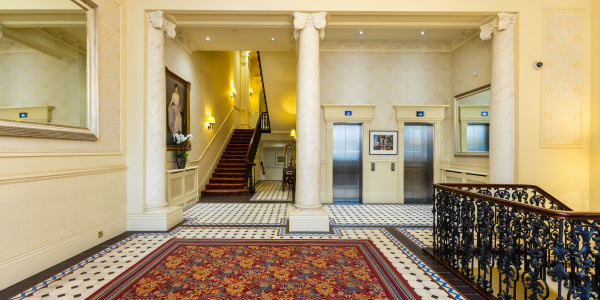Improving energy efficiency solutions for buildings is no longer optional. Rising energy prices, regulatory pressures and Net Zero targets mean that building owners and facilities managers must act now. The right building energy efficiency solutions can cut costs, improve comfort and reduce carbon output without compromising performance. Practical, energy efficient building solutions are available for all types of buildings, and when combined they deliver significant long-term benefits.
At Cube Controls, our Business Energy Assessment service identifies where energy is being wasted and provides a clear plan of action. If you want to understand how your building performs and what can be done to reduce energy use, now is the time to arrange an assessment. Contact us today.
Why Energy Saving Matters Now
Building energy consumption in the UK continues to account for a significant share of national demand.
In 2023, overall UK energy use declined across all sectors. The domestic sector showed the largest fall, down 6.0% to 32.2 MTOE (millions tons of oil equivalent – a unit quantifying the amount of energy released by the burning of a million tonnes of crude oil). Industry use dropped by 1.1% to 20.4 MTOE , while the services sector decreased by 1.3% to 19.8 MTOE (ECUK 2024). These reductions reflect both high temperatures and continued high energy prices, but they also show that energy consumption in buildings is not fixed – changes in conditions, behaviour and technology can bring measurable reductions. (At the time of writing, 2024 data has not yet been published.)
From our 20 years of experience working with building management systems and energy projects, we have seen many organisations underestimate the scale of energy use within their premises. The impact of inefficient operation goes beyond cost. It affects compliance, occupant wellbeing and a business’s ability to meet sustainability commitments. Many buildings operate far below optimal efficiency simply because systems are outdated, incorrectly programmed or poorly maintained. By addressing these issues with proven building energy efficiency solutions, organisations can deliver meaningful results quickly.
5 Key Areas to Target for Energy Efficiency Solutions
Energy savings are achievable when you focus on the right priorities.
1. Building Envelope Improvements
The envelope (including walls, roof, windows and doors) directly affects heating and cooling demand. By upgrading insulation, sealing air leaks and replacing inefficient glazing, organisations can comply with building energy efficiency standards and cut heating loads. These are recognised building energy efficiency measures that deliver consistent results. Even modest changes, such as adding roof insulation or upgrading window seals, can create a more energy saving building without large capital investment.
2. Smart Building Technologies
Smart technologies give building managers real-time insights into how energy is used and wasted. Connected sensors track occupancy, temperature, lighting and equipment use, and the data feeds into automated systems that respond instantly. For example, heating or cooling can be scaled back in unoccupied areas, and lighting can adjust to available daylight.
Smart controls in commercial buildings have been shown to reduce energy use, often with little or no impact on comfort. Based on Cube Controls’ experience, many of the quickest wins come from adjusting how existing systems respond to occupancy and usage, rather than major hardware changes. This makes smart systems one of the most cost-effective energy management building technologies available.
Automation also supports compliance, because systems can document energy use trends and ensure performance stays within agreed limits. For facilities managers, this means less manual monitoring and more consistent efficiency gains.
3. HVAC System Upgrades and Optimisation
Heating, Ventilation and Air Conditioning (HVAC) represents one of the largest energy loads. A typical commercial building uses over 40% of its total energy just on operating HVAC systems (Cube Controls). Regular servicing, controls upgrades and demand-based ventilation are all proven steps in how to reduce building energy consumption.
We have worked with clients in industrial and office settings where updating HVAC software alone has cut energy use by noticeable amounts. Improving energy efficiency in industrial buildings is rarely about replacing every component. More often, it is about adjusting schedules, sensors and setpoints to align with how the building is actually used today.
4. Renewable Energy Integration
Installing renewables directly reduces dependence on grid energy. Solar photovoltaic (Solar PV), heat pumps and battery storage are now mainstream energy efficient building technologies, with 98,469 hydronic heat pumps sold in the UK in 2024, a 63% increase over the previous year (Heat Pump Association).
For organisations aiming for energy efficiency in buildings on the path to Net Zero, renewables not only reduce emissions but also provide long-term cost stability. When integrated with a Building Management System (BMS), renewable generation and storage can be optimised to support demand peaks and balance loads.
5. Operational and Behavioural Changes
Technology alone cannot deliver full efficiency. Staff behaviour and building operation play a central role. Training occupants to switch off unused equipment, reviewing cleaning schedules to reduce after-hours usage, and monitoring occupancy patterns all contribute to improving energy efficiency in buildings.
At Cube Controls, we’re often asked by facilities managers about how to improve the energy efficiency of a building without major investment. The answer lies in operational reviews and low-cost actions such as updating control settings, adjusting operating hours and enforcing accountability. For larger organisations, these small steps are the starting point of how to improve energy efficiency in commercial buildings.
With Cube Controls’ Building Controls Industry Association (BCIA) accreditation which reflects recognised expertise in building energy management, and our track record in building management, we help facilities managers put these solutions into practice through clear, prioritised upgrades that improve performance and lower bills.
How These Solutions Work Together and What to Prioritise
Effective energy building solutions are rarely about a single measure. The best results come from combining actions so each one reinforces the others:
- Envelope upgrades reduce heating and cooling demand
- HVAC systems then operate under less strain, lowering overall consumption
- Smart controls ensure equipment only runs when needed
- Renewables cover part of the remaining demand with low-carbon energy
- Operational and behavioural changes lock in savings and keep performance on track
A clear energy efficiency building solution prioritises these steps in a logical order:
- Start with the least disruptive, lowest-cost changes, such as reviewing control schedules or staff training
- Progress to mid-level upgrades with measurable payback, like insulation improvements or lighting control
- Plan larger capital investments, such as renewables or HVAC replacement, when budgets and building lifecycles align
Cube Controls’ Business Energy Assessment supports this process by identifying inefficiencies and setting out a prioritised action plan. This ensures that energy efficiency works are not only technically effective but also aligned with budgets, compliance needs and long-term Net Zero goals.
Energy Efficiency Solutions for Buildings: Real-World Examples
Our customers often want to see how efficiency measures work in practice. Across the UK, organisations have already achieved meaningful savings by focusing on the areas outlined above.
- Hospitals: Adjusting control schedules for heating and ventilation reduced out-of-hours energy use, cutting operating costs while maintaining critical indoor conditions.
- Schools: Installing smart lighting and occupancy sensors lowered electricity demand, helping budgets stretch further without affecting learning environments.
- Commercial offices: Reviewing HVAC setpoints and reprogramming existing control software brought immediate reductions in energy bills without major capital outlay. Find out how Bloomberg HQ, London achieved its ‘Outstanding’ BREEM rating, saving up to 600-750 MWhr of power each year here.
These projects serve as practical energy efficient buildings examples that demonstrate what is achievable. Across the UK, such steps are helping create more energy efficient buildings, showing that targeted actions and expert guidance can deliver tangible results.
Next Steps and Implementation Checklist
Before investing in upgrades, it is essential to establish a clear baseline. A building energy performance assessment provides this clarity, highlighting how energy is currently used and where the main inefficiencies lie. The results can influence compliance with a building energy performance certificate and improve the overall building energy efficiency rating.
A structured assessment typically involves:
- Collecting building and utility data, including energy bills and installed equipment
- Reviewing operating conditions and occupancy patterns
- Analysing building behaviour, such as seasonal changes and schedules
- Identifying energy conservation measures and the potential for savings
- Considering the needs of building owners, operators and occupants
Cube Controls’ energy assessment service focuses on these areas, with particular attention to HVAC and control systems where the biggest opportunities often lie.
“Our role is to help building owners take control of their energy use. By focusing on practical changes, backed by accurate data, we give clients a clear route to cut costs and support sustainability targets.”
– Tony Williams, Founder of Cube Controls
To learn more about what an assessment involves, please visit our Business Energy Assessment service page.
Moving Forward with Energy Efficiency
Reducing building energy consumption is achievable when upgrades and operational changes are applied in the right order. Reviewing the building envelope, adopting smart technologies, optimising HVAC, integrating renewables and encouraging behavioural change all contribute to sustained improvements. Together, these steps support energy efficiency and sustainability in buildings, aligning with both cost-saving goals and Net Zero commitments.
Organisations that act early benefit from lower running costs, stronger compliance with regulations and improved occupant comfort. The message is clear: energy efficiency is not a one-off project but an ongoing process that requires data, expertise and commitment. With the right plan in place, meaningful reductions can be achieved without sacrificing performance.
Frequently Asked Questions
What is energy efficiency in buildings?
It is the practice of using less energy to achieve the same level of comfort, safety and performance. This involves measures such as insulation, smart controls, efficient HVAC systems and renewable energy integration.
How to improve the energy efficiency of a building?
Start with a building energy performance assessment. From there, introduce low-cost improvements like optimising control schedules and training staff. Larger steps can include insulation upgrades, HVAC optimisation and renewable technologies.
How do building energy saving solutions work?
They reduce demand, improve how systems are controlled and replace high-carbon energy with low-carbon alternatives. Each measure on its own saves energy, but combined they deliver bigger, long-term reductions.
What 7 things can be done to increase energy efficiency?
- Improve the building envelope (insulation, glazing, sealing etc.)
- Introduce smart building technologies
- Optimise or upgrade HVAC systems
- Integrate renewable energy
- Change operational practices
- Encourage occupant behavioural change
- Carry out regular performance reviews and updates
Cube Controls is an established and experienced supplier of Building Management Systems, specialising in the design and set up of bespoke environmental and energy control programmes for commercial buildings and property.
To find out how Cube Controls can support you at all stages of design and consultancy, installation and modification and maintenance of your building management systems contact our expert and friendly team on 01903 694279 or sales@cubecontrols.co.uk.




